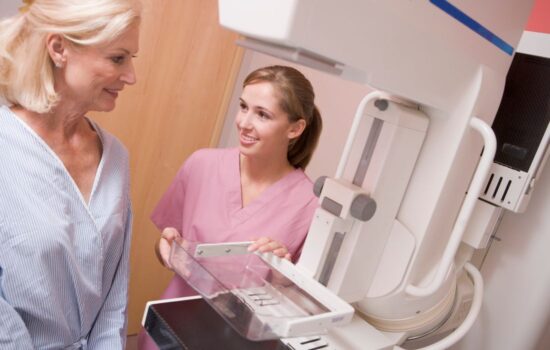May 8, 2024
What To Expect Following an Abnormal Mammogram

Regular breast cancer screening with a mammogram makes it possible to detect breast cancer in its earlier stages when it's easier to treat. If your mammogram results show an abnormality, your doctor will let you know the next steps. In most cases, it will include additional imaging. Knowing what an abnormal mammogram means and what to expect next will help you through the process if this happens to you.
Additional Diagnostic Imaging After an Abnormal Mammogram and the BI-RADS Score
Although mammograms are a valuable tool for screening, doctors do not rely solely on the results to diagnose breast cancer. Instead, they are likely to order additional imaging tests to examine any areas of concern further. The results of those images will determine if a biopsy is necessary. Several diagnostic imaging methods can be used:
Diagnostic mammogram: This type of mammogram is similar to a screening mammogram, but more images are taken. Retaking the mammogram can help confirm whether something seen on the initial mammogram was just a shadow or fold in the tissue rather than a lump that requires further investigation.
Ultrasound: Ultrasound is another imaging test that can determine if a breast lump is a solid tumor or a cyst. During an ultrasound, the patient lies flat on a table while an ultrasound technologist uses a small device to scan the breast. The resulting images help the doctor obtain a better view of any abnormalities in the breast tissue.
Breast MRI: MRI scans may also be used to provide additional diagnostic information after an abnormal screening mammogram. They use radio waves and magnets to create detailed images of the inside of the breast.
Understanding Your BI-RADS Score
After breast imaging tests, your doctor receives a report that includes a Breast Imaging Reporting and Data System (BI-RADS) score. This score ranges from 0 to 6 and helps the doctor determine how to proceed.
A score of 0 indicates that there is not enough information to make a determination.
A score of 1 means there is no sign of cancer.
Scores of 2 or 3 indicate that something was noticed, but it does not appear to be cancer, and the patient should be monitored over time.
Scores of 4 or 5 mean that there is a lump that could be cancerous, and a breast biopsy is recommended to confirm the diagnosis.
A score of 6 means that the biopsy has confirmed the presence of cancer.
My Diagnostic Imaging Tests Indicate Breast Cancer. Now What?
While the diagnostic test may indicate the likelihood of breast cancer, the only way for your doctor to confirm a diagnosis is with a biopsy.
Breast Biopsy to Determine if Cancer is Present
A breast biopsy involves taking a small tissue sample from the breast using a long needle. Sometimes, the area is numbed to make the procedure more comfortable. This procedure usually takes 60 to 90 minutes. Imaging scans are frequently used to ensure the precise removal of tissue from the area of concern.
Breast Biopsy Pathology Report
After a biopsy, a pathologist at a lab examines the sample under a microscope to confirm if cancer cells are present. If they are, the pathologist will also look for other cell characteristics to determine the exact breast cancer type. The breast cancer specialist will discuss the results with you and use this information to plan the best treatment approach.
Related reading:
What Is a Breast Pathology Report and How Does It Impact Your Next Steps?

What Happens When Breast Cancer is Indicated on the Pathology Report?
If the pathology report confirms a breast cancer diagnosis, you will start seeing an oncologist, a doctor who specializes in cancer treatment. Breast cancer treatment is often complex and requires a multidisciplinary approach. The medical oncologist will lead the breast cancer care team, which includes other breast cancer specialists such as the surgeon and radiation oncologist. Together, they develop a comprehensive treatment plan tailored to your specific type of breast cancer.
During your first appointment with the oncologist, you will learn more about your diagnosis. This usually includes reviewing the results from your biopsy and any imaging and hormone status testing you had. This is also a good opportunity to discuss your concerns, preferences, and expectations. The oncologist may recommend additional testing as needed to gather more information about your breast cancer, such as whether it has spread to lymph nodes or other areas of the body.
Find out how to plan for your first visit with a breast cancer specialist.
Treatment Planning for Breast Cancer
Breast cancer treatment varies among patients because each case is unique. The oncologist considers many factors, including your age and overall health, as well as the specific type of breast cancer and its characteristics, such as the tumor size, the stage, hormone receptor status, and lymph node involvement, when determining the best treatment approach.
Breast cancer treatment uses a variety of approaches, including:
Surgery. Surgery to remove a breast tumor is usually a standard part of treatment. Lumpectomy, or breast-conserving surgery, is often used for early-stage breast cancer, followed by radiation therapy to that area of the breast. After consulting with you, the oncologist and breast surgeon will recommend a treatment option.
Radiation therapy. Radiation therapy uses high-energy beams to kill cancer cells. Your doctor may recommend radiation therapy in combination with surgery. Radiation can be given before or after the surgery. Learn more about breast cancer radiation.
Hormone therapy. Hormone therapy is a treatment approach used for breast cancer that has hormone receptors. Hormones like estrogen and progesterone feed the cancer’s growth. Hormone therapy works by blocking the production of these hormones to slow the cancer growth.
Chemotherapy. Chemotherapy uses drugs to kill cancer cells. It is necessary if the cancer cells have spread to the lymph nodes. Once in the lymph nodes, cancer can circulate throughout the body. Chemotherapy is able to circulate throughout the body to kill cancer cells wherever they are located.
Targeted therapy. Targeted therapy uses drugs to attack specific proteins in the cancer cells. These drugs are designed to target proteins like HER2 that help the cancer cells grow and spread. Targeted therapy drugs are only used for specific types of breast cancer, and the side effects are different and usually less severe than those of chemotherapy.
Immunotherapy. Immunotherapy stimulates your body’s immune system to attack cancer cells. It may be recommended for treating breast cancer that has come back locally or for triple-negative breast cancer. It can also be used when surgery is not an option or for cancer that has spread to other parts of the body (metastasized).
Choosing the best breast cancer treatment approach depends on various factors, such as the type, hormone status, and stage of the breast cancer, your overall health, and your preferences. Your medical oncologist will review your test results and work with the surgeon and radiation oncologist to determine the recommended treatment plan.

Breast Cancer Specialists in Brevard County, Florida
The breast cancer doctors at Cancer Care Centers of Brevard offer the latest breast cancer treatments and are here to provide you with an individualized treatment plan. If you were recently diagnosed with breast cancer, schedule a consultation with one of our oncologists. We serve several areas in Florida, including Melbourne, Merritt Island, and Palm Bay.
Categories: Breast Cancer